|
|
Expedition
Expedition | People
|
Log - August-8-2003
by Gerhard Behrens and Robert McCarthy
Previous | Next
No more "ball and rope"
Robert McCarthy |
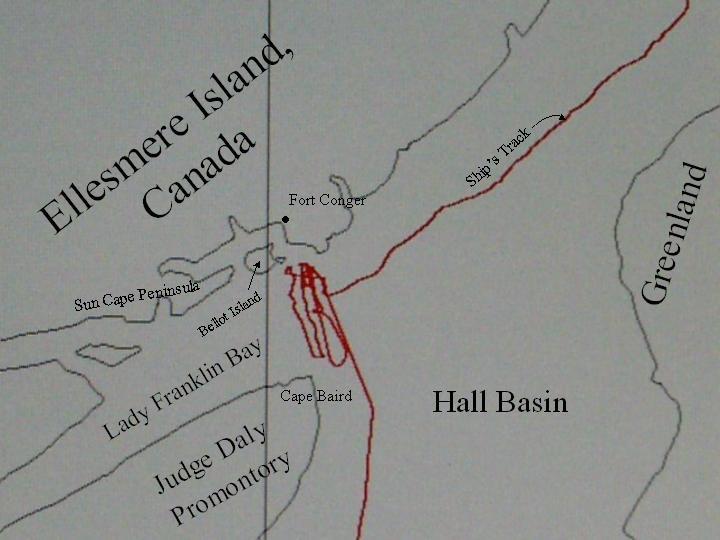 |
The Challenger Expedition was the first “Oceanographic cruise”. Their sole mission was to learn more about the oceans. It lasted over 3.5 years, and traveled more than 160,000 km. (That’s 4 times the earth’s circumference!) Back in those days, part of their mission was to measure how deep the oceans were. The procedure was to lower a massive greased ball attached to a rope until the tension in the rope changed. This signified that the ball was on the bottom, and then they would measure how much rope was spooled out. If the ball came up with no sediment sticking to the grease, they realized that it didn’t hit the bottom, and that cast would be redone. Think of how time consuming that must have been and with thousands of meters of rope overboard; it must have weighed more than the greased ball, so determining when the tension changed must have been speculative at best. Plus, rope would go off at an angle to the ship, so measurements were very crude. Even with all those drawbacks and difficulties, the Challenger completed over 500 depth measurements throughout the world’s oceans. |
| Sound is very efficient in traveling through water, and its speed is roughly 1500 m/s, over 4 times as fast as in air. (It’s interesting to note that our ears are keyed in to listening for sound in air. With our eyes closed, if someone makes a noise, we can fairly accurately determine the location of that sound source by the time differential between our two ears. However, the same “experiment” in water, because of the sound differential being smaller, is not as accurate in determining the direction of the source.) The speed of sound in water is a function of the temperature, salinity, and pressure, and there is a depth region in the oceans where sound travels the fastest. This region is called the SOFAR channel, and whales have been known to transmit their songs through this region for tens to hundreds of kilometers. Early in the 20th century, echo sounding became widely used to measure the ocean depths. A sound signal was emitted from the ship, and they listened for the return signal from the bottom reflection. Knowing the speed of sound in seawater, and the time of round trip travel (from the ship to the bottom and back to the ship), the distance traveled by the sound wave was calculated. Then the depth of the ocean at that location was just half this distance. These were termed “soundings”, and the mapping of the oceans took a giant leap forward. However, the bottom information was limited to an area directly under the ship. |
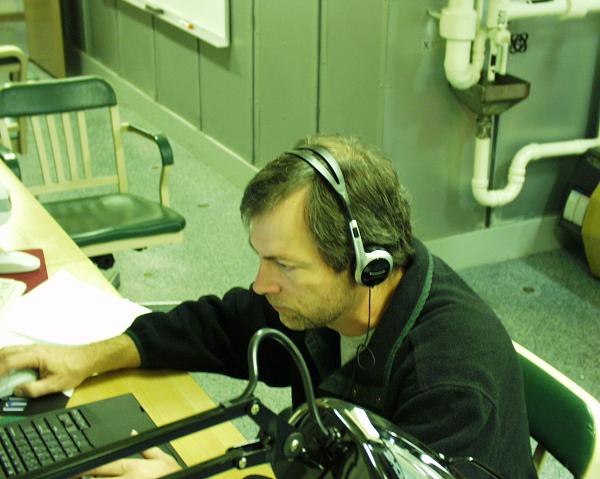 |
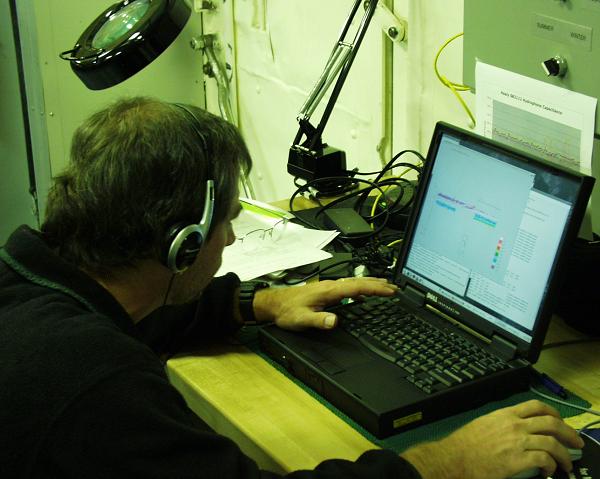 |
Enter the “Sea Beam 2112”! The Healy is equipped with this instrument which is mounted to the ship’s hull. This is a “multibeam bathymetric survey system”, which means that it sends a series of signals down with 128 beams directed at different angles and maps the bottom in a 120 degrees swath perpendicular to the path of the vessel. Roger Davis with the University of Hawaii is the Sea Beam expert on the ship. He showed me the manual, and although I didn’t study it, the physics resembles diffraction of light by a narrow slit. The sensors are looking for constructive interference, which differ by an integer wavelength to the emitted signal, and regions of destructive interference, where the return signal is a ½ integer wavelength apart. The frequency of the emitted signal is also of concern. Too high a frequency and attenuation (the reduction in amplitude due to frictional losses) is a problem. The energy of the sound wave per unit of time is power, and power is proportional to amplitude squared. Another concern is the signal to noise ratio. This measures the strength of the emitted signal to the background noise and essentially is a measure of the detectability of the return signal. So there’s tons of physics involved in generating the bottom bathymetry. |
| This region between Greenland and Ellesmere Island is not heavily traveled by ships, and hence the maps of the bottom are not so precise. The Healy did not get too close to land yesterday while the small boat operation was looking for more clams. The bottom steeply sloped up towards land, and there could have been very shallow shoals that would not appear on the nautical charts. So we stayed our distance, and ran parallel transits back and forth to the entrance of Lady Franklin Bay. Basically we traversed between Fort Conger and Cape Baird (on the tip of Judge Daly Promontory) to map the bottom while we waited for the dive team to return. Here is a color-coded map of the bottom produced by the output of the Sea Beam. This map is the result of 5 ship transits, pieced together. Notice the latitude: 81 degrees, 38 minutes in the center of the plot. That’s way-the-heck up here, and just a little more to go to reach the Lincoln Sea. Here’s hoping! |
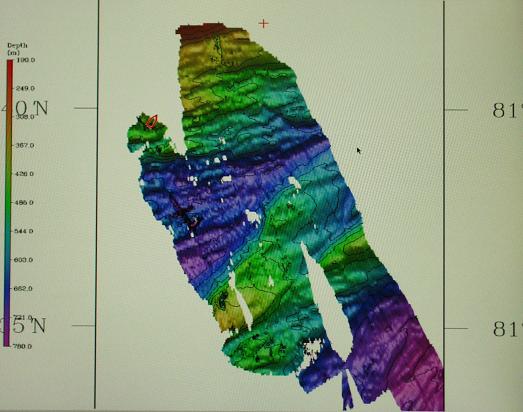 |
Help wanted: Oceanographer
Gerhard Behrens |
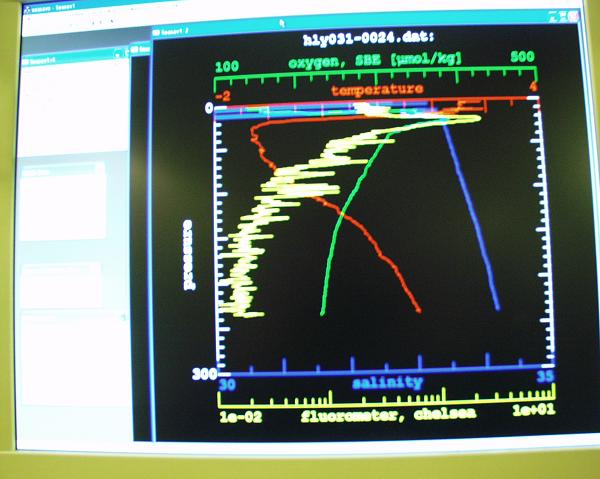
Chemical Oceanographers watch a monitor that shows the salt, temperature, and oxygen of a cast for water samples. |
Yesterday, the ship was geared up for all kinds of action: take more water samples, put in another mooring, get ready for a coring, think about another clam site. Last night, the wind blew in at 40-50 knots and whipped up some choppy waves. Now, none of that is happening due to some rough seas. But I still thought about how much has happened on the ship, and how many ways there is to be involved in oceanography. |
| Check out these VERY short job descriptions: |
| Chemical Oceanography: These scientists are looking at the chemicals of the ocean to understand its secrets: salt, temperature, gases such as oxygen and carbon dioxide, nutrients such as phosphate, metals such as cadmium and barium. |
| Physical Oceanography: This is about physics; the forces in action that affect the water: how water flows, ocean currents, spin of the earth, air pressure, changes in ocean temperature and salt levels. |
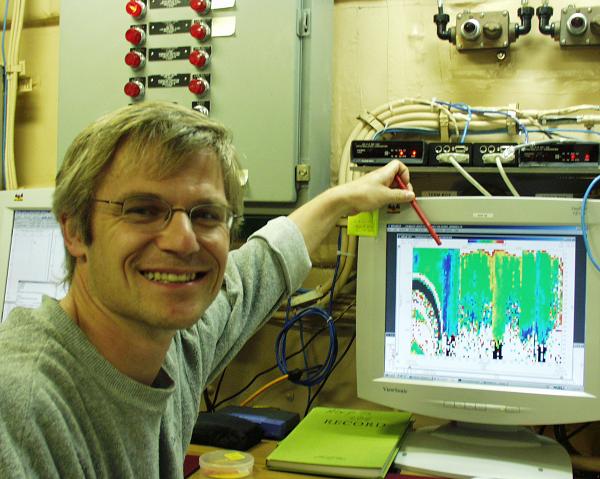
Physical Oceanographer, Andreas Meunchow, checks data on depth, current, and salinity. |
| Marine Geology and Geophysics: This oceanographer looks at the earth below the water, studying the rocks, minerals, mud, layering, and fossils. |
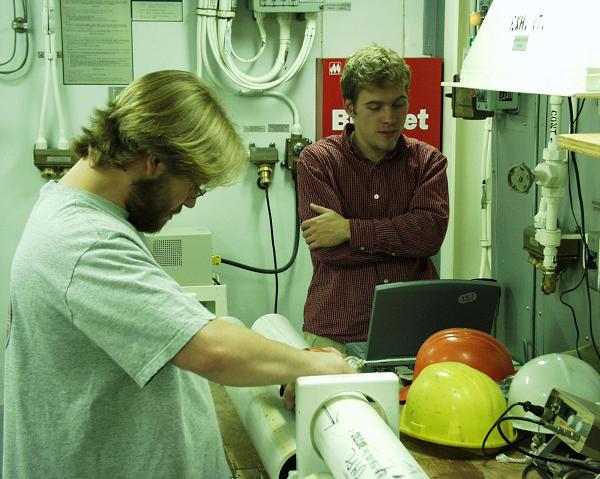
Chip Heil, a student in Geographical Oceanography, checks his coring sample for magnetic susceptibility. (How magnetic is the mud from the ocean floor?) |
| Biological Oceanography: This is the most famous kind, but it’s only one kind! You would study the plants and animals of the sea if you were in this field, and your title might include zoology or botany. |
| A person can’t just be one kind of oceanographer. Each one of those oceanographers has to know a lot about the other kinds because oceanographers often work together to answer the questions they have about how the ocean is behaving. |
| You can also work in oceanography with a slightly different twist. These people help the scientists collect and share their information and samples. |
| Analytical Technician: These workers are doing things with the water to find out about its chemistry. They mix chemicals with seawater and they use very special machines to discover what is in the very plain looking water. They have to be very careful about what they mix and how they mix, and they must understand how to use very complicated machines. |
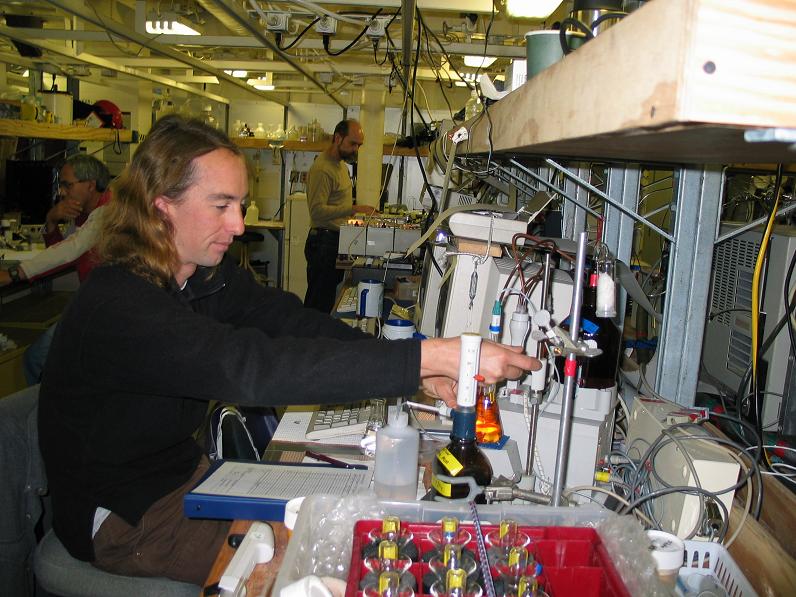
Dale Hubbard finds out how about the oxygen in these samples. Joe Jennings, in the rear, is looking for nutrients. |
| Mooring Technician: These folks put ocean-measuring equipment in the water. That’s easy for me to write and very hard to do. |
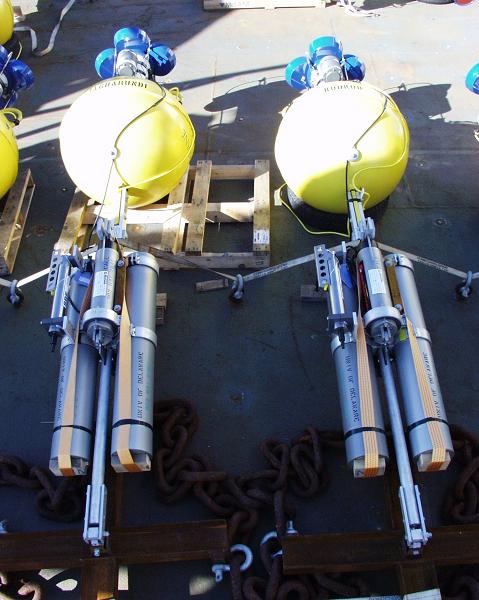
Mooring technicians work with scientists to design, build, and set out ocean measuring tools like this one to measure ocean pressure in shallow depths. |
| Coring Technician: This is also easy to write and hard to do: these workers get samples of the earth below the ocean floor.
The mooring techs and coring techs must have a wide range of skills: electrical engineer, electrician, mechanical engineer, mechanic, blacksmith, welder, heavy equipment operator, and most important, inventor and problem solver. |
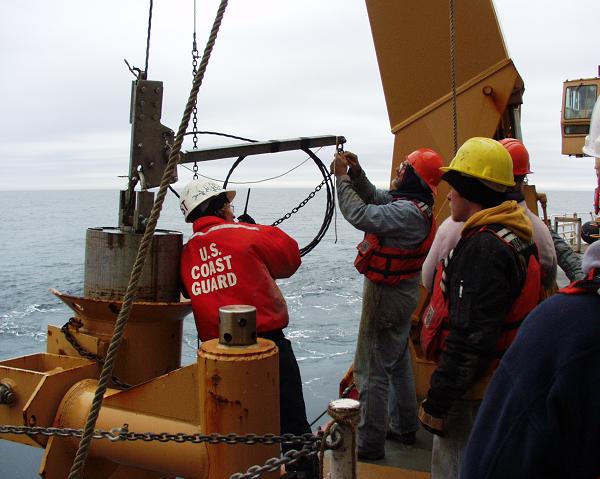
Coring technicians handle the heavy equipment that goes down for a sample of the ocean’s bottom. |
| Marine Resource Management: People in this field want to teach others about the ocean: its water, its plants, and its animals; especially how to best use and protect the ocean’s gifts. |
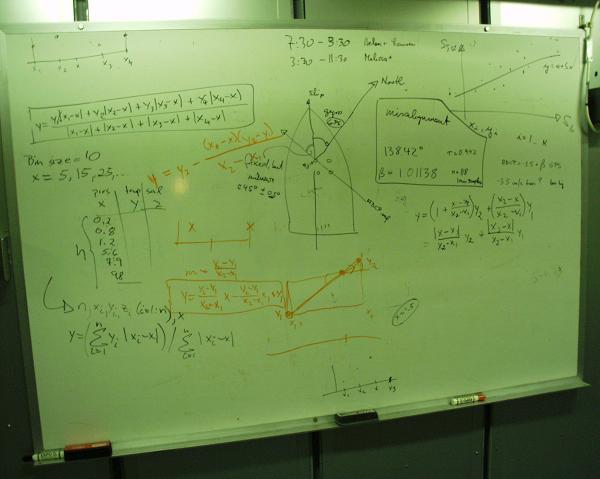
You need some math skills! |
| There are lots of other people making this cruise possible. Meteorologists help oceanographers plan for the weather. Cartographers provide detailed maps of the ocean floor. To prepare for work in oceanography, a student has a wide choice of subjects to choose from. On this cruise, science team members have studied many different things: physics, chemistry, material sciences, music, and even fine arts. But, everyone shares a love of the ocean and how it works. |
|
